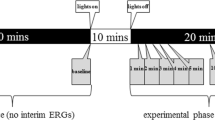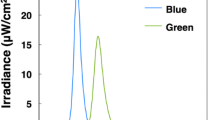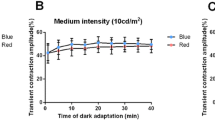Summary
-
1.
Short-wavelength light produces prolonged changes in the ERG afterpotential and the size of the ERG response to a fixed testflash; these changes may be reversed at any time by long-wavelength light: this ‘blue/ orange adaptation’ is clearly separable from other components of light or dark adaptation (Fig. 3), and operates over a totally different time scale (Fig. 10a,b).
-
2.
The amount of light required to produce a criterion change in the state of blue/orange adaptation of the eye is independent of the intensity or temporal pattern of the stimulus (Figs. 1, 2, 3, 4, 5, 6 and Table 2).
-
3.
Recovery of sensitivity in darkness following an intense blue stimulus is extremely slow (hours); and at any time during the recovery of sensitivity, blue light will again diminish sensitivity or orange light restore it (Fig. 10a, b).
-
4.
The response amplitude elicited by a testflash is highly negatively correlated with the size of the ERG afterpotential (a) during blue-adaptation (Figs. 1, 2, 3), (b) during the decline of the ERG afterpotential resulting from exposure of the blue-adapted eye to long-wavelength light (Figs. 4, 5, 6, 7), (c) during dark-recovery from blue-adaptation.
-
5.
The data presented are consistent with the view that the adaptational changes described result from interconversions of R480 and M580; that the size of the prolonged ERG afterpotential is closely linked to the amount of M580 in R1−6 following transduction; that the effects observed in the ERG closely reflect events occurring across the transducing membranes of R1−6; and that there is a component of the membrane conductance of R1−6 that is correlated with the presence of M580.
Similar content being viewed by others
References
Brown, H.M., Cornwall, M.C.: Ionic mechanism of a quasi-stable depolarisation is barnacle photoreceptor following red light. J. Physiol. (Lond.)248, 579–593 (1975)
Cone, R.A.: The internal transmitter model for visual excitation: some quantitative implications. In: Biochemistry and physiology of visual pigments (ed. H. Langer), pp. 275–282. Berlin-Heidelberg-New York: Springer 1973
Cosens, D.: Some factors affecting the rate of dark adaptation in certain insects. J. Insect Physiol.17, 955–968 (1971)
Cosens, D., Briscoe, D.: A switch phenomenon in the compound eye of the white-eyed mutant ofDrosophila melanogaster. J. Insect Physiol.18, 627–632 (1972)
Cosens, D., Wright, R.: Light elicited isolation of the complementary visual input systems in white-eyeDrosophila. J. Insect Physiol.21, 1111–1120 (1975)
Fein, A., Cone, R.A.:Limulus rhodopsin: rapid return of transient intermediates to the thermally stable state. Science182, 495–497 (1973)
Harris, W.A., Stark, W.S., Walker, J.A.: Genetic dissection of the photoreceptor system in the compound-eye ofDrosophila melanogaster. J. Physiol. (Lond.)256, 415–439 (1976)
Hamdorf, K., Schwemer, J.: Photoregeneration and the adaptation process in insect photoreceptors. In: Photoreceptor optics (eds. A.W. Snyder, R. Menzel), pp. 263–289. Berlin-Heidelberg-New York: Springer 1975
Hochstein, S., Minke, B., Hillman, P.: Antagonistic components of the late receptor potential in the barnacle photoreceptor arising from different stages of the pigment process. J. gen. Physiol.62, 105–128 (1973)
Kirschfeld, K.: Optics of the compound eye. In: Processing of optical data by organisms and machines (ed. W. Reichardt), pp. 144–166. New York-London: Academic Press 1969
Laughlin, S.B.: Receptor function in the apposition eye-an electrophysiological approach. In: Photoreceptor optics (eds. A.W. Snyder, R. Menzel), pp. 479–498. Berlin-Heidelberg-New York: Springer 1975
McCann, G.D., Arnett, D.W.: Spectral and polarisation sensitivity of the dipteran visual system. J. gen. Physiol.59, 534–558 (1972)
Meffert, P., Smola, U.: Electrophysiological measurements of spectral sensitivity of central visual cells in the eye of blowfly. Nature (Lond.)260, 342–344 (1976)
Minke, B., Hochstein, S., Hillman, P.: Antagonistic process as source of visible-light suppression of afterpotential inLimulus UV photoreceptors. J. gen. Physiol.62, 787–791 (1973)
Minke, B., Wu, C.-H., Pak, W.L.: Isolation of light-induced response of the central retinula cells from the electroretinogram ofDrosophila. J. comp. Physiol.98, 345–355 (1975)
Muijser, H., Leutscher-Hazelhoff, J.T., Stavenga, D.G., Kuiper, J.W.: Photopigment conversions expressed in receptor potential and membrane resistance of blowfly visual sense cells. Nature (Lond.)254, 520–522 (1975)
Nolte, J., Brown, J.E.: Ultraviolet-induced sensitivity to visible light in ultraviolet receptors ofLimulus. J. gen. Physiol.59, 186–200 (1972)
Ostroy, S.E., Wilson, K., Pak, W.L.:Drosophila rhodopsin: photochemistry, extraction and differences in the norp Ap12 phototransduction mutant. Biochem. biophys. Res. Commun.59, 960–966 (1974)
Pak, W.L.: Mutations affecting the vision ofDrosophila melanogaster. In: Handbook of genetics, Vol. 3 (ed. R.C. King), pp. 703–733. New York: Plenum 1975
Pak, W.L., Lidington, K.T.: Fast electrical potential from a long-lived, long-wavelength photoproduct of fly visual pigment. J. gen. Physiol.63, 740–756 (1974)
Razmjoo, S., Hamdorf, K.: Visual sensitivity and the variation of total photopigment content in the blowfly photoreceptor membrane. J. comp. Physiol.105, 279–286 (1976)
Shaw, S.R.: Polarised light detection and receptor interaction in the arthropod eye. Ph.D. thesis, University of St. Andrews (1968)
Stark, W.S.: Spectral selectivity of visual response alterations mediated by interconversions of native and intermediate photopigments inDrosophila. J. comp. Physiol.96, 343–356 (1975)
Stark, W.S., Zitzmann, W.G.: Isolation of adaptation mechanisms and photopigment spectra by vitamin A deprivation inDrosophila. J. comp. Physiol.105, 15–27 (1976)
Stavenga, D.G.: Dark regeneration of invertebrate visual pigments. In: Photoreceptor optics (eds. A.W. Snyder, R. Menzel), pp. 290–295. Berlin-Heidelberg-New York: Springer 1975
Wulff, V.J., Stieve, H., Fahy, J.L.: Dark adaptation and sodium pump activity inLimulus lateral eye retinula cells. Vision Res.15, 759–765 (1974)
Author information
Authors and Affiliations
Additional information
Richard Wright was supported by a postgraduate research studentship granted by the Science Research Council. We thank Brian Pennington and Maurice Dow who helped with the statistics and criticised the manuscript, and an anonymous referee who made a number of helpful suggestions.
Rights and permissions
About this article
Cite this article
Wright, R., Cosens, D. Blue-adaptation and Orange-adaptation in white-eyedDrosophila: Evidence that the prolonged afterpotential is correlated with the amount of M580 in R1−6 . J. Comp. Physiol. 113, 105–128 (1977). https://doi.org/10.1007/BF00610456
Received:
Issue Date:
DOI: https://doi.org/10.1007/BF00610456




